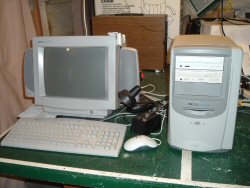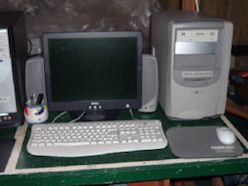HP Pavilion 6330 Upgrade
This is now my old machine for tinkering. I have a new Dell 8200 with a Pentium 4 2.4 GHz CPU that is much faster.) My computer was a HP Pavilion 6330 with an AMD K-6-2 300 mhz CPU, 4.1 GB Quantum Bigfoot harddrive, Goldstar 24X CD ROM drive, Generic floppy drive, 48 MB memory with 4 MB of it being used for the video and Windows 98 in its original form. I've upgraded this computer: The memory was replaced with two 128 MB, 100 mhz SDRAM modules making for a total of 256 MB. The
mother board only has two memory banks with a maximum of 256 MB because of the BIOS. I had to removed the old modules. A 10.1 GB Maxtor harddrive was added. This drive fail on 10/22/02 and was replaced with a new larger 30 GB Maxter drive (Maxter Diamond Max Plus 8 30 GB Model No# 6E030L0 ). The new Maxter drive is quiet and much faster than the old one.(Less boot time and faster data retrievel). The old 4.1 drive became "D Drive" and is for data storage only. I've installed a 16-10-40X BTC BCE1610M CD-RW drive. It came with Nero 5.5 CD Burning software. the drive performs great with Nero. For the CPU upgrade, I've first tried with an AMD K 6-2 500 mhz CPU. The highest speed that I can get it to work was 455 mhz. It didn't boot at the 500mhz setting. I think the power supply wasn't able to supply the current. An AMD K-6-2 500 mhz CPU at 500mhz setting draws 14 AMPS @ 2.2 Volts. The original CPU draws 9 or 10 AMPS at 300 mhz. I think I can get more proformance out of this computer than this without changing the motherboard and power supply. I did some online research and found sites on the AMD K 6-2 Plus (http://www.k6plus.50megs.com/, http://web.inter.nl.net/
hcc/J.Steunebrink/k6plus.htm#bios and http://www-stud.uni-essen.de/~sw0729/amdk62plus/
eindex.htm ) The AMD K 6-2 Plus CPUs was designed for notebook computers not desktop ones. The reason for using this CPU is better proformance. This CPU has an on die CPU speed L2 cache of 128 KB Plus this CPU draws 2/3 less power than the K 6-2s. When used on this computer, there are a total of three levers of caches mormories ( L1 64KB, L2 128KB and L3 512KB). Because it uses less power, I think I can use the 500 mhz setting. At the 500 mhz setting this new CPU would use only 9.5 AMPs @ 2 volts. This is even less than the original CPU at 300mhz. The AMD K 6-2 CPU has no on die L2 cache momory. The L2 cache of 512 KB is on the motherboard and it runs at a slow speed of the system bus. It was, also the most overclockable K 6 CPU in the AMD line. I went and ordered online a AMD k 6-2 Plus 450 mhz at
http://www.tigerdirect.com/applications/category/category_slc.asp?Id=2201. I paid a total of $45 for it. With this CPU, the computer boot at the 500 mhz setting. But the problem is the BIOS doesn't recognize this CPU. At boot up, it only say K 5 and no speed. This means not everything on this CPU is enable. To enable everything I had to download and install this program "CTU" from >http://unirefresh.demonews.com/ctu/<. The jumpers for the CPU core voltage was set at 2 volts on the motherboard. This is the lowest setting for this system. The bus multiplier was set at 2X. On all AMD K 6-2 CPUs that is 400 mhz or higher ( a CXT core), the 2X setting is Interpreted as 6X by the CPU. (BF0 2-3) (BF1 1-2) and (BF2 open) The motherboard's highest setting is only 5.5X. The system bus was set at the highest for this motherboard at 83 mhz (FS0 2-3) (FS1 1-2) (FS2 1-2) and (FS3 2-3). The normal system bus speed is 66.66 mhz. At this setting the PCI bus speed is too high at 42 mhz. The normal is 33 mhz. But everything works fine. Some PCI cards may not work at this speed. I had to use this setting in order to get 500 mhz from this motherboard (83 X 6 = 500). This motherboard doesn't have a 3X setting for the PCI to system bus. It only has a 2X setting. The motherboard for this computer is a Asus SPAX 1.01 all in one. The BIOS is Phoenix Technologies 1.10 Rev. 02/12/99. With this CPU and setting this computer is more then twice as fast as before than, when using the original AMD K-6 2 300 mhz. I've did a benchmark test using Sandra 2002 and the results were (CPU MULTI MEDIA-- Intege MMX 1694 it/s & Floating
Point 3D Now! 2168 it/s)(CPU ARITHMETIC BENCHMARK-- Dhrystone ALU 1324 MIPS & Whetstone FPU 596 MFLOPS)(MEMORY BENCHMARK--RAM Int MMX Bandwidth 108 MB/s & RAM Float FPU 107 MB/s). Sandra 2002 can be downloaded from http://download.com. (Update) On the second try, I was able to get the AMD K 6-2 500 CPU to boot at 500 mhz, after lapping the heat sink with fine sand paper to make the surface more flat . The BIOS does shows AMD K 6-2 (tm) 500 mhz . Its
not as fast as an AMD K 6-2 Plus CPU at the same speed. I found a better program to enable the features of this CPU from http://www.powertweak.com/ its a twenty day shareware program.
I feel, its a good ideal to keep the program CTU on the computer to check and adjust the speed. You can also use this program to enable this CPU. Its not as easy to use as powertweak 2 but its a free program. This is because, it sometimes doesnt enable at boot up and you would have to do it manually while Powertweak 2 does it everytime so far. The AMD k 6-2 that is 400 mhz and above comes with the CXT core. I found it to be faster than a non CXT CPU. When working inside your computer, please observe precautions for handling electrostatic sensitive devices. Wear a grounding wrist strap before working inside your computer. This upgrade works on my computer and may not on yours. Be sure, you have an Asus SPAX 1.01 motherboard before upgrading. Although after this upgrade, this computer was just as unstable as before except being more than twice as fast. Because of this, I don't feel that this is a worth while upgrade. The motherboard and CPU upgrade would have been much better. I just happened to made a mistake and wasted my money. but, I did learned a lot about computer operation from tinkering with this system.
As you can see, the computer case is very compact which precludes the use of a Pentium 4 motherboard. Here, I was trying to do a low cost upgrade on this old machine. It would have been a better idea for me, to simply junk this machine and start from scratch. With a state-of-the-art Pentium 4 system, I would have to get a new case with a ATA-12V Pentium 4 certified power supply, a Pentium 4 motherboard, CPU, CPU fan, new DDR memories,a new floppy drive and a new graphic card. The rest of the components can be reuse on this new system.
Since I have newer system, the Dell 8200 with a Pentium 4 at 2.4 GHz. I didn't feel the need to go this far with the upgrade of this computer.
This computer was modified again with a new Soyo motherboard (Soyo SY 7IWM/L1.0) with a 1 Ghz Celeron Coppermine processor, a new 180 watts power supply and a 40 GB Maxtor hard drive that came off my Dell Dimension 8200 computer. The 40 GB Maxtor hard drive was used to
replace the old "slow" 4 GB Quantum Bigfoot hard drive in "C"position. On this drive I've installed Windows XP Home Edition. This new combination works extremely well with Windows XP is very fast and stable also works extremely well with with Dragon NaturallySpeaking Version 6. This new motherboard also support selective booting, by this it means you can select the
operating system without going into the BIOS at startup. Unlike the old motherboard that does not support Windows XP or selective booting. When I tried installing Windows XP with the old motherboard, it was very unreliable. I was getting the blue screen of death constantly and it also freezes a lot. This 1 Ghz Celeron processor is just as fast as the Pentium 3 at 1 Ghz according to Sandra 2003 benchmarking utility. Or approximately almost half the speed of my Dell Computer with a 2.4 Ghz Pentium 4 processor. The reasons I chose this motherboard was because it was on sale as a combo with the Celeron processor and fan/heatsink for only $64 with free shipping back in August, 2003. Also,I can reuse my old 100 MHz SDRAM memory sticks, All of the places that sells this motherboard combo no longer stock them anymore. The motherboard came with an integrated video with a maximum of 18 MB shared and sound card. The graphics is not bad for shares system and is much better than the old motherboard. This computer now have three operating systems (Windows 98 Second Edition on "D"drive and Windows XP Home Edition on "C and G"drives). This CPU is overclocked to 1.05 Ghz. Also, on this system the original Goldstar CD-ROM drive was recently trashed. In its place, a new second CD burner (MSI 52X 24X 52X). This new CD burner is the best and fastest one that I have. I only pay $33 for it, shipping included.
This computer is upgraded again for the 3rd time to a used ASUS Intel 815E chipset CUSL2 motherboard. A Tualatin adapter was also purchase so I can use the fastest Pentium three CPU. The CPU that I eventually used on this computer is the server class Tualatin Pentium 3 at 1.4 GHz with 512 kB of cache memory. This CPU was overclocked to 1.522 GHz in the motherboard's BIOs. After this modification the speed of this computer is very close to a 2 GHz Pentium 4 system. This will be the fastest that I can go with this computer it while keeping the old HP case along with the 180 W power supply. Being a compact case the way it was designed, the drive bay would be in the way of the CPU with the huge cooler that would be needed for Pentium 4 system. The old 14 inch CRT monitor is retired. In its place, the 15 inch LCD Dell monitor from the our Dell computer as well as the 64 MB graphic card are used. After this upgrade, this computer is much more pleasant to use. Even though it's pleasant to use it is still not fast enough for my taste, so I end up building another computer. This new computer is a Pentium 4 at 3.4 GHz.
|
|
|

This is with the Soyo motherboard mounted

This is with the ASUS motherboard mounted

ASUS Intel 815E chipset CUSL2 motherboard